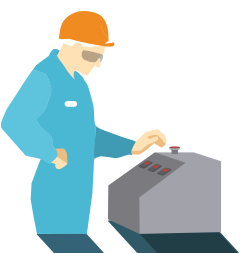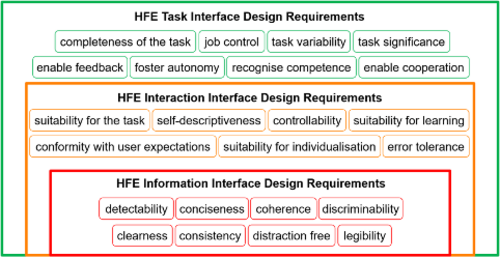General Interaction Design Principles
The design process for human-system interaction includes three different but interrelated interfaces, i.e., the task, the interaction, and the information interface.
Task interface design
- analyses of system goals, functions, activities, and information required.
- allocates functions to operator and/or to technical components of a work system (e.g., machinery).
- covers task requirements for system design.
Interaction interface design
- interfaces the human operator for task interactions (e.g., dialogue) with the technical system.
- respects human performance capabilities and limitations while at the same time considering principles of human information processing.
Information interface design
- covers information modalities (e.g., visual), objects (e.g., text) and passive or active impacts (e.g., label, control, feedback) on human information processing.
The selection of design requirements as presented in Figure 1 refer to the design of interfaces and support human factors and ergonomics as well as occupational safety and health in work system design.
Interaction interface design
Designing the interaction interface is to be done appropriate for the tasks. Human task performance capabilities and limitations (e.g., vision, language, memory, size of fingers) define the design requirements for interaction interface design. The design of human-system interaction interfaces according to requirements facilitates operator interactions to perform assigned tasks safely and efficiently.
Please select among the following interaction interface design requirements to get more information:
- Suitability for the Task
- Self-Descriptiveness
- Controllability
- Conformity with User Expectations
- Error Tolerance
- Suitability for Individualisation
- Suitability for Learning
References
- EN 614-2 (2008). Safety of machinery – Ergonomic design principles – Part 2: Interactions between the design of machinery and work tasks. Brussels: CEN.
- EN 894-1 (2010). Safety of machinery – Ergonomics requirements for the design of displays and control actuators – Part 1: General principles for human interactions with displays and control actuators. Brussels: CEN.
- Kantowitz, B.H., Sorkin, R.D. (1983). Human factors: Understanding people-system relationships. New York: Wiley.
- Wickens, C.D., Hollands, J.G., Banbury, S., Parasuraman, R. (2013). Engineering Psychology and Human Performance. Upper Saddle River: Pearson.


